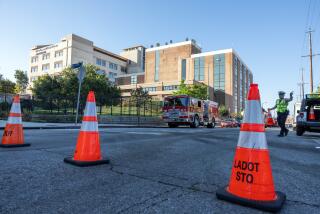Doctors at USN Hospital Rebel Over Deficiencies
- Share via
In an unusual act of open rebellion, a group of doctors at the Long Beach Naval Hospital say they have ceased admitting seriously ill patients because of what they say are major and potentially hazardous inadequacies in equipment, services and personnel at the hospital.
The six physicians, from the hospital’s internal medicine department, detailed their concerns in a recent memo to their commanding officer that was made available to The Times.
“The internal medicine department has had to confront a steadily decreasing set of patient care resources,” the doctors said in the memo. “Recently these deficiencies have progressed to the point where we feel that patients may be endangered.”
According to a recent internal audit of services, for instance, the facility cannot sufficiently handle the treatment of allergies, heart ailments, gynecological problems, childbirth or surgery to the hand, throat or blood vessels.
History of Frustration
Dr. Frederick L. Jones, head of the department and one of the memo’s signers, said that the move was the culmination of long-simmering frustrations over the deficiencies, some of which were outlined in the memo.
Another staff physician, who did not sign the memo and who spoke only on condition that his name not be used, said: “I feel scared that my patients are being taken care of in a system where the level of accountability and responsibility is very, very low. I think that (because of the lack of medical support), any patient I operate on is at higher risk of a negative outcome than a similar patient on the outside.”
Officials at the facility--the only naval hospital in Los Angeles County and one which is considered a full-service general acute-care facility--deny that patients there receive less than adequate care. They also dispute the doctors’ assertion that admissions have decreased in the last few months and characterize the memo simply as a particularly dramatic expression of the frustrations that most Navy doctors share.
However, they acknowledge the chronic health care problems that beset most military hospitals. The military health care system has been in crisis for years. Ever since the end of the Vietnam War, military medical facilities throughout the country have been trying to balance the demands of ballooning patient loads with a dwindling supply of resources, while struggling to attract and retain experienced physicians.
“Nobody is more keenly aware of the problems facing Navy medicine than Navy medicine,” said Pat Kelly, a Navy spokeswoman based in San Diego.
Years of Crisis
But at the Long Beach Naval Hospital, some doctors say, the situation has become so acute that patients’ lives are being endangered and doctors’ spirits sorely tested. Many of their complaints are documented in the recent series of internal hospital memos.
Since 1985, according to the Navy, the number of staff physicians at the site--a 114-bed facility serving nearly 300,000 active duty military personnel, retirees and dependents--has dwindled from 68 to 38, a 44% decline that has necessitated the curtailment of several major medical services. Although this is comparable to the experience of other area naval hospitals, officials say, the response has been especially pronounced at Long Beach. Staff morale, according to one experienced Navy physician, is at an all-time low--”the worst I’ve ever seen any place.”
The memo dated Nov. 30 that was signed by the six internal medicine doctors outlines a number of hospital deficiencies. For example, the memo mentions the hospital’s “shrunken” radiology department, which offers no in-house weekend service; a “poorly stocked pharmacy” lacking such rudimentary medications as Tylenol; basic supply shortages, “including alcohol wipes and IV (intravenous) solutions”; frequent “unavailability of crucial laboratory tests,” and the longstanding absence of specialists capable of dealing with anything but routine ailments.
Shared Resources
While doctors acknowledge that naval hospitals throughout the country suffer from similar shortages, the hospitals often share resources by trading patients in a sort of “mixing and matching” of services. But for patients in Los Angeles County, the doctors say, the closest full-service naval hospital outside Long Beach is 50 miles to the south at Camp Pendleton, raising the specter of wasting valuable time trying to transport seriously ill patients to hospitals capable of treating them.
“Because such problems are so significant and widespread,” the memo went on to say, “we no longer feel medically or ethically capable of caring for patients whose illness is not minor. For their own protection we therefore will no longer admit patients who may require intensive care to this hospital. Regrettably, we can see a time when no medicine patient could be admitted to this facility.”
Hospital officials deny that overall admissions have gone down since the memo was written, despite the doctors’ assertions that they are carrying out their pledge. The officials add, however, that they have no way of gauging the relative seriousness of the illnesses suffered by those admitted now compared to those admitted in the past.
And while acknowledging that major gaps exist in the services they can provide, the officials say that they routinely refer patients in need of unavailable medical services to better equipped military or civilian facilities, though apparently not often enough to satisfy the signers of the memo.
“I would read (the memo) as saying that these doctors were being dramatic in trying to confront an issue that they thought was insurmountable when, in fact, it wasn’t insurmountable had they gone through (proper channels), “ Navy spokeswoman Kelly said. “Even the existence of this memo shows the concern that our providers have for their patients.”
While the document was initially treated as a “routine quality assurance memo” that raised no red flags, Kelly said, it was scrutinized more closely after inquiries by The Times. Since then, she said, a Navy inspector general has visited the site and determined that the deficits mentioned in the memo were temporary and did not affect patient care.
But this is not the first time questions have been raised regarding the level of care offered at the Long Beach Naval Hospital, which was commissioned in 1967. Three years ago, the hospital closed its emergency room after a Navy inspection report concluded that it lacked a department head and was staffed by physicians without significant emergency medicine experience. “The (quality review and risk-management) program in the emergency room is virtually non-existent,” Navy inspectors reported in the 58-page document.
The memos obtained by The Times also indicate a pattern of complaints by various physicians over the last two years. “Major problems remain: the lack of emergency and acute care (as well as) inexperience of the nursing and ancillary staff in support of the physicians,” noted one department head in a 1987 memo. “Morale of the staff remains poor and retention is abysmal.”
A year later the same doctor, who is no longer at the hospital, complained in writing to his superiors that “the current crisis facing Navy medicine began with an arrogance that we could continue to do more with less. Our primary goal must be to realize that our resources are diminishing to a critical level and to continue to provide quality care some difficult decisions will have to be made.”
How to Continue?
Some of those decisions involve the question of how to continue operating without being able to offer some services ordinarily associated with a full-service acute-care hospital, which is how Navy officials describe the Long Beach facility.
According to the hospital’s recent internal audit--a monthly inventory of medical services distributed Navywide--the hospital lacks, among other things, a cardiologist, an allergist and an obstetrician/gynecologist. Services available only on a limited basis, meanwhile, include internal medicine, echo-cardiograms, treatment of ailments having do with the eyes or nervous system, the treatment of children and the taking of X-rays.
Doctors are reacting to the shortages in various ways.
Some agonize over which patients to keep and which to refer elsewhere. Others, like the memo signers, say they are sending more and more to civilian facilities, even though visits to non-military hospitals by military personnel or dependents cost the government about $100 apiece, compared to the average $30 cost of visits to the Navy hospital.
Still other physicians, many of whom have been complaining for at least a year about the growing necessity of turning away seriously ill patients, choose to leave the Navy completely and set up more lucrative private practices.
“I trained for a long time to do a lot of different things and I couldn’t do them there,” said Dr. Richard Furman, echoing widely held sentiments constituting what the Navy acknowledges as a major problem. Frustrated by the deterioration of his skills through lack of use and concerned about the potentially hazardous effects should he ever be required to treat seriously ill patients, Furman left the Long Beach Naval Hospital last June to open a private practice in Suffolk, Va.
“We just didn’t take on sick patients,” he said. “You lose all your skills and I didn’t train all this time to lose all my skills.”
More to Read
Sign up for Essential California
The most important California stories and recommendations in your inbox every morning.
You may occasionally receive promotional content from the Los Angeles Times.













